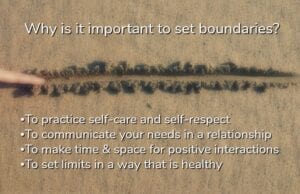 One of the most vital components to creating a fulfilling relationship is to set healthy boundaries. Simply put, boundaries are what set the space between where you end and the other person begins.
One of the most vital components to creating a fulfilling relationship is to set healthy boundaries. Simply put, boundaries are what set the space between where you end and the other person begins.
For some people, setting boundaries can be extremely difficult. We have to learn when it is the proper time to set a boundary and how to find a balance in setting boundaries so they are not too weak or too rigid.
This is why communicating your boundaries clearly is key. But what does this look like? Healthy boundaries include everything from speaking up when you think you are being disrespected to advocating for yourself to have time for your own interests.
Types of Boundaries
There are several areas where boundaries apply:
- Material boundaries: determine whether you give or lend things, such as your money, car, clothes, books, food, or toothbrush.
- Physical boundaries: relate to your personal space, privacy, and body. Do you give a handshake or a hug – to whom and when? How do you feel about loud music, nudity, and locked doors?
- Mental boundaries pertain to your thoughts, values, and opinions. Are you easily suggestible? Do you know what you believe, and can you hold onto your opinions? Can you listen with an open mind to someone else’s opinion without becoming rigid?
- Emotional boundaries: separates your emotions and responsibility for them from someone else’s. Healthy emotional boundaries require clear internal boundaries – knowing your feelings and your responsibilities to yourself and others.
- Sexual boundaries: protect your comfort level with sexual touch and activity – what, where, when, and with whom.
- Spiritual boundaries: relate to your beliefs and experiences in connection with God.
- Digital Boundaries: pertain to how you interact with the digital world such as social media. You should share your feelings on when it is okay to post, tag, or text before you share your statues, and respect those digital boundaries.
Though learning how to properly and effectively set boundaries can be a long process, here are basic steps to begin setting boundaries in your relationships.
Steps To Setting Boundaries:
Know yourself.
The first step in setting any boundary is self-knowledge. You need to know what you like and dislike, what you are comfortable with, what scares you, and how you want to be treated in given situations. Recognize and acknowledge your own feelings. Is this person making you feel overwhelmed or drained?
The problem with many people who have weak boundaries in relationships is that they become so encompassed by the other person’s “stuff” that they have no idea what it is they are feeling. By taking the time to break away, reflect, and really check in with yourself, you are then consciously making the distinct difference between yourself and the other person.
Be clear about your needs.
After you know what your feelings and needs are, tell your partner. Many boundary violations stem from not telling the other person especially when one partner has a problem with certain behaviors. Often this is because they worry it’ll trigger an argument. However, it’s OK to have preferences, and it’s OK to let your partner know. For example, if you want to be treated as an equal with financial issues, tell your partner.
Recognize when your boundaries have been crossed.
Maybe a friend is always asking to borrow money from you but they never pay you back or you find yourself answering your friend’s text or phone calls late at night and it’s causing you to lose sleep. It is important to recognize who has crossed a boundary and how often that person does it.
Be specific and direct.
Make your boundary known — communicate it to the other person. The more specific you are with communicating your boundaries, the better. A few examples may be telling a person who often borrows money that you are not letting them borrow anything else until you get paid back what you’ve already given. If it is a friend who is constantly texting or calling you late at night when you’re trying to sleep, then maybe you want to tell them that you won’t answer any texts after 10 pm because you need to sleep – and then stop answering them.
When voicing your boundary, use “I” statements. “I” statements help you own your own feelings and allow your partner to feel less defensive. Rather than saying, “You need to do this,” use such phrases as: “I feel,” or “I would appreciate.”
Be clear about your love, while being clear about your boundaries.
Communicate to your partner how much you care about them. If they’ve overstepped a boundary, mention it by explaining the importance of the boundary to you. An example would be saying, “I need you to know that I love you and have every intention of us working through whatever issues come up. But I am not OK with you being verbally abusive when you get angry. If you want to talk about how it upset you that I ran into my old girlfriend, we can do that, but only if you don’t attack me.”
Get grounded.
There are two things that often happen when boundaries in relationships have been weak:
- There is backlash from the other person. The reality is that if there is a backlash then the other person isn’t respecting your boundary. If we acknowledge their disrespect by arguing with them, then we are giving them what they want: A weakness of our boundary. By acknowledging and focusing on their backlash we are then subconsciously telling them that we are not grounded within ourselves and confident in what we want.
- You feel guilty. Remember that your emotions are valid. For that reason, you are not wrong for setting your boundary. Remember, you are taking care of yourself, which is something that we should all do above all else. Once you get practice setting boundaries, you feel empowered and suffer less anxiety, resentment, and guilt. Generally, you receive more respect from others and your relationships improve.
Take care of yourself.
If setting the boundary brought up any backlash or feelings of guilt, then be sure to take care of yourself. Go for a walk, exercise, be out in nature, etc. Do something to help yourself get re-centered and try not to spend energy focusing on what happened.
Ultimately, healthy relationships require clear-cut parameters. For instance, most couples agree that cheating is a boundary violation. But what does cheating mean in your relationship? Is it physical contact, going to lunch, sharing secrets with a colleague, fantasizing about someone, or watching porn? When you are clear about the boundaries you have set; what the rules, goals, and expectations are, the relationship can be stable.

Bonus: Digital Boundaries
One boundary that is often not talked about is social media and using digital devices. It can be hard to know where the line between healthy and unhealthy is once a relationship goes online. For instance, you might be happy to post all the details of your romance online, but your partner might not. You should share your feelings before you share your statues, and respect those digital boundaries.
When you talk to your partner about your online relationship, see what makes you both feel comfortable by considering your digital boundaries:
- Is it okay to tag or check in?
- Do we post our relationship status?
- Is it okay to friend or follow my friends?
- When is it okay to text and what is the expectation for when we return it?
- Is it okay to use each other’s devices?
- Is it okay to post, tweet, or comment about our relationship?
Once you know how you each feel, you can create a digital dating agreement between the two of you. Together, you can decide what feels healthy and what doesn’t for each of you. There may be some negotiating and compromising as you figure out an agreement that works for both of you. But if your partner asks you to do something that just doesn’t feel right, or they try to control you in some way, that’s when you get to say that this isn’t healthy for you. This digital dating agreement can be changed as you continue with your relationship.
